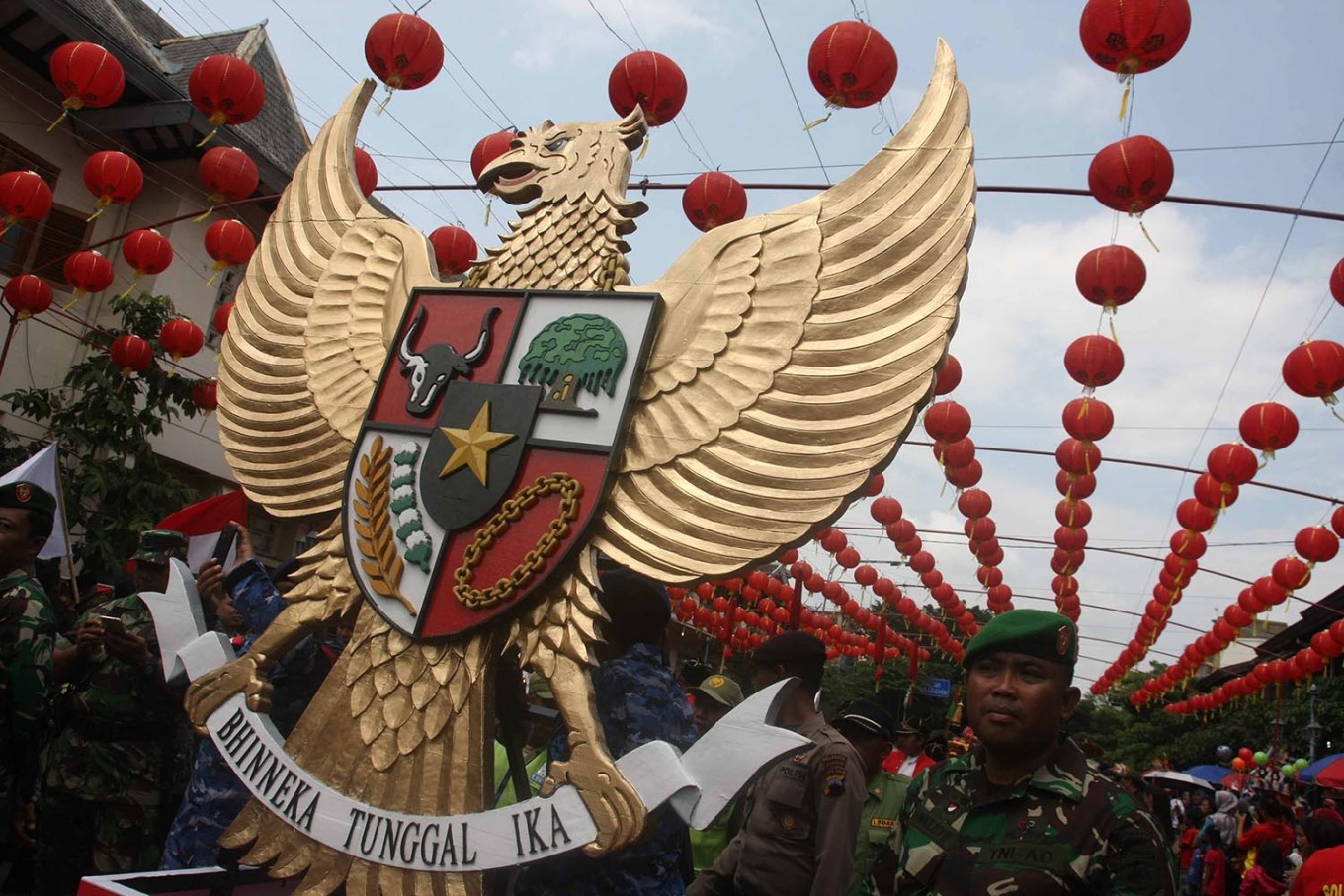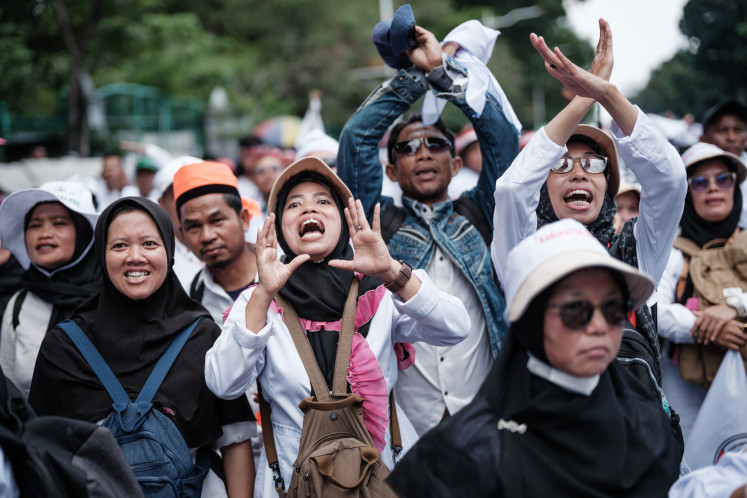Popular Reads
Top Results
Can't find what you're looking for?
View all search resultsPopular Reads
Top Results
Can't find what you're looking for?
View all search resultsBhinneka Tunggal Ika as guiding principle needs revisiting
From religious to ethnic discrimination, in schools and through the country’s history, Indonesians seem to feel discomfort in addressing issues of ethnicity, presumably promoting homogeneity in the name of cultural understanding of diversity. This is important to address, especially starting from within schools.
Change text size
Gift Premium Articles
to Anyone
I
n Indonesia, education is considered a tool for strengthening social cohesion in a country where prosperity and living standards are unequally distributed, especially along regional lines. Yet practices within educational institutions often do not reflect this regard of unity in diversity to reach such gains, sometimes even sustaining practices of implicit – at times explicit – exclusion.
From religious to ethnic discrimination, in schools and through the country’s history, Indonesians seem to feel discomfort in addressing issues of ethnicity, presumably promoting homogeneity in the name of cultural understanding of diversity. This is important to address, especially starting from within schools.
With the Javanese population being the majority ethnicity, national history, civil servants, migrants and teachers are often disproportionately Javanese — implying that minority groups’ identities, experiences, histories, origins and cultures are easily overlooked.
This issue of inclusivity in the country – or lack thereof – is perverse and spans generations. The most recent reports of these have been that of religious discrimination – with Indonesia being the most populous Muslim country in the world. Some schools have required non-Muslim female students to wear the hijab, with reports of students canceling their enrolment after being asked to sign a document declaring to do so despite their Catholic faith.
Arguably, because of the prevalence of religious discriminatory practices taking the forefront of these headlines, discrimination against ethnic minorities is often sidelined. Not only that, ethnic discrimination is often rooted in imbalances of power and (resource) extraction.
Two ethnic minorities with such contentious histories and have an associated stereotype are the Chinese-Indonesians and the Papuan people. These groups hold very different narratives, but both are major victims of the discriminatory environments that have — and still do — surround them. Without more targeted interventions to counteract continuous acts of discrimination to (and even from) these groups, it can create siloes of deepening echo-chambers that reinforce their own “popular narratives”.
Noting that Chinese-Indonesians and Papuans are mostly non-Muslim minorities, this may additionally play an underlying role in the negligence of this discriminatory practice. Keeping quiet may only perpetuates this.
In 1998, the country’s failing economy turned Chinese-Indonesians into a convenient scapegoat for the failing economy. It forced Chinese-Indonesians to fear their ethnic identity; they changed their names, as well as the names of their newborns and accepted being regarded as second-class citizens and the trauma from the “true, native” Indonesians.
Post-1998, those more well-off typically fared fine, but for those who did not have such economic security, the lingering fear seemed to hit closer to home.
On the other end, Papuans suffered a similar but different fate — arguably to a worse extent. The Papuan province is the most naturally resource-rich area in the country. It is also the least developed province in the country in terms of the Human Development Index (HDI). The exploitation of their land led them to experience longstanding racist treatments and being easily taken advantage of. They are harshly stereotyped for what they are not in control of and dehumanized when they move or migrate to urban areas for work or education. Due to this, people often feel implored to treat them as second-class citizens – to the extent of often treating them like slaves when working as manual labor.
Though arguably not as outright as it has previously been, and with Indonesia’s younger generation seeming more empathetic about these issues, these structural issues will prevail.
As schools are the gate for a child’s entry point into society, they must introduce the child to the heterogeneity of the society they will later partake in. Students should be supported with the skills to navigate and adapt to society – or societies.
Therefore, schools must mediate multicultural awareness, starting by practicing inclusion in classrooms, offering history lessons and engaging in deeper cross-cultural understanding, as this will benefit both the students as learners and later on the nation as they become productive citizens.
As it is important for children to be taught in their own (mother-tongue) languages, it is also just as important to see themselves represented in the spaces they reside – in the histories that they read and to understand their positions in the wider community. These especially hold true for students of different socioeconomic backgrounds, where economic disparities may be a significant part of one’s association to their identity.
A 2018 PISA report shows that children who are more exposed to different cultures in schools are more likely to have positive intercultural attitudes. Students from socioeconomically disadvantaged backgrounds are also more likely to benefit from such learning activities than their more advantaged peers who have more opportunities for exposure outside of school. In a country so rich and diverse, empowering the variety of groups can lead to maximizing the country’s untapped potential.
In New Zealand’s implementation of Maori Education, for example, Maori students were taught about their identities by learning about their culture, customs, ethnicity, etiquette and fashion, strengthening Māori students’ identities while joining non-Māoris on a journey toward shared cultural understanding. There are benefits gained by all students by collectively learning about their indigenous roots, and by doing so, “the concept of unity through diversity is embedded within the school culture”.
While this may be difficult without a shift in the fundamental understanding of Bhinneka Tunggal Ika (Unity in Diversity), it is an important step to take. Conformism is often championed on top of valuing differences, with “unity in diversity” regarded as “out of many, one”.
Multicultural pedagogy in public school classrooms often focuses on similarities instead of acknowledging and teaching about understanding differences in their classrooms, coexisting and adapting to one another through intentional integration of social and emotional learning (SEL) and actively providing examples for students from teachers and the school community.
In Indonesian civic education textbooks, despite showcasing the principles of Unity in Diversity, they “emphasize domestic inclusiveness and does not refer to the various ethnic an tribal groups as minorities”. If not carefully treaded, this may have its own negative connotations and marks exclusivity in the center of teaching and learning about Bhinneka Tunggal Ika. With the lack of attention paid to building shared cultural understanding on the identities of ethnic minorities, cultural diversity and heterogeneity, it is important to understand the values of diversity and the traits that Indonesia wants to hone in its young people and next generations.
Similarly, Students can easily reflect the attitudes of teachers, especially attitudes toward people of other cultural backgrounds. As Indonesia has an uncomfortable relationship with confronting issues of (racism and) ethnicity, schools need to extend beyond the typical rote-memorization of teaching and learning of mere content knowledge to the expansion of positive attitudes to navigate a world of diversity and change.
Educators teaching the next generation must be aware of the values they reflect as Indonesian citizens. Every student, regardless of ethnicity or regional backgrounds, must be enabled to thrive.
With the ease of stereotype perpetuation, homogeneity above true unity in diversity, more work needs to be done to ensure that students can navigate different spaces in a country so culturally rich and diverse.
The writer is an international education policy student at the Harvard Graduate School of Education.










